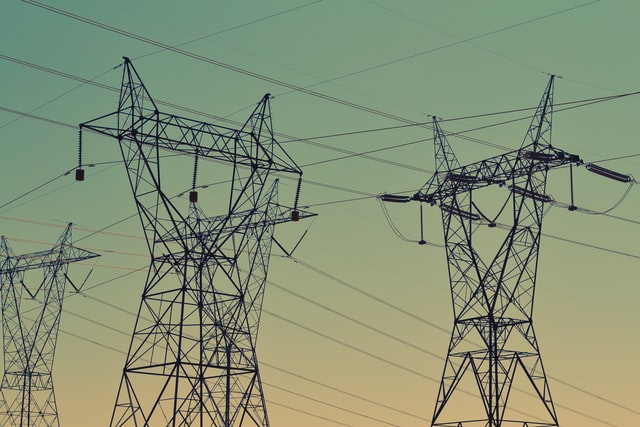The wildfires of 2018 did not just set ablaze much of the western coast of the US, they also lit a fire underneath the utility companies in the state of California when it soon became apparent that unmaintained power lines were a major factor in starting fires.
High wind events and an aging network infrastructure, in combination with the ever-climbing Californian temperature, created a perfect storm whereby wildfires were not only taking place, they were becoming more frequent.
That's where GO 95 comes in.

WHAT IS GENERAL ORDER 95 (GO 95)?
General Order 95 – or GO95 - is the utility code for overhead lines in the state of California. Designed by the California Public Utilities Commission (CPUC), it provides a set of guidelines that utility providers must abide by legally or be penalized.
The code specifically refers to overhead lines, be they electric or telephonic, and guides providers in terms of line design, line construction and most relevantly to us, line maintenance (also known as Rule 18).
HOW IT WORKS
The rule can be most easily broken into five main points. A provider must:
- Take responsibility for their own assets by regularly inspecting them.
- Inform third party companies when the original provider’s asset directly affects a third-party’s asset.
- Notify third party providers or companies should a fault or hazard be discovered while inspecting their own asset.
- Act on any notification received from a third-party company that informs them of a hazard relating to their own asset.
- Keep a clear and detailed record of all inspections that have been conducted of their assets for at least 10 years.
LEVELS OF SEVERITY
How quickly a GO95 violation must be remediated is dependent on the level of the hazard. Factors that help determine the level of classification include; type of equipment, location, whether it’s in a fire-threat district, accessibility or the surrounding climate. The classifications are as follows:
Level 0 or ‘Safety Hazard’: A condition that poses significant threat to human life.
The most serious of all levels and where a fix must take place immediately. In this instance a Cyberhawk team member would contact the relevant provider directly while on-site to advise them of the hazard.
Level 1: An immediate risk of high potential impact to safety or reliability.
In this instance, a provider must take corrective action immediately; either by fully repairing or by temporarily repairing and reclassifying to a lower priority.
Level 2: Any other risk of at least moderate potential impact to safety or reliability.
The provider must, in this case, take corrective action within a specified time period (either by fully repairing or by temporarily repairing and reclassifying to Level 3 priority). The time period for corrective action would be determined at the time of identification by a qualified company representative, but must not exceed: (1) six months for potential violations that create a fire risk located in Tier 3 of the High Fire-Threat District; (2) 12 months for potential violations that create a fire risk located in Tier 2 of the High Fire-Threat District; (3) 12 months for potential violations that compromise worker safety; and (4) 36 months for all other Level 2 potential violations.
Level 3: Any risk of low potential impact to safety or reliability.
Corrective action must be taken by the provider within 60 months subject to specified exceptions.
WHAT HAPPENS IF YOU DON’T COMPLY?
Non-adherence to the order, whether that be unacceptable maintenance records or physical failings of the assets themselves, such as fittings failures or conductors falling to the ground, can lead to significant financial penalties for the provider.
The gravity of these fines will depend in part on the provider’s general compliance to the order, i.e whether their maintenance records are of a good standard, or how hazardous the fault in question is.
In one instance in 2007, a provider was investigated after 3 utility poles fell in high wind and subsequently started a fire that would burn over 3,836 acres. The resulting fine cost the responsible company $37 million.
However, more consequential than any fine are the physical dangers that a lack of regular maintenance and record keeping provide.
GO 95 not only insists that a provider regularly maintains and preserves their own assets, but equally, they should inform other providers if an inspection should lead to the discovery of a fellow operator with hazardous assets.
Keeping this open line of communication between companies is key to preserving safety, preventing accidents – and ultimately saving lives.
If you’re interested in finding out how Cyberhawk can support your project
download your free power grid capabilities overview pack now!
CYBERHAWK & GO 95
Our unrivalled experience in drone inspection allows us to make sure utilities assets are up to code in the safest, quickest way possible.
To help us complete that task most efficiently and consistently, we created our own extensive, in-house set of guidelines of the order that not only follow the original law to the letter, but have included additional useful items that have drawn on our years of experience to help us catalogue faults.
As part of our inspections, we use our own Cyberhawk Defect Categorization grading system to record just how hazardous – or not – an asset component might be. This lets the provider know quickly just how urgent a repair is needed.
Our report also includes a working catalogue of all known asset parts, possible failures and how that failure would be graded as a hazard by the above categorizations.
As part of each inspection we take on, we make sure our engineers are well-versed in the order and are aware of any changes that have been made to it, should that be the case.
LET US HELP YOU
If you are a utilities provider based in California, we can help you remain GO 95 compliant. Reach out to us today to find out how.
